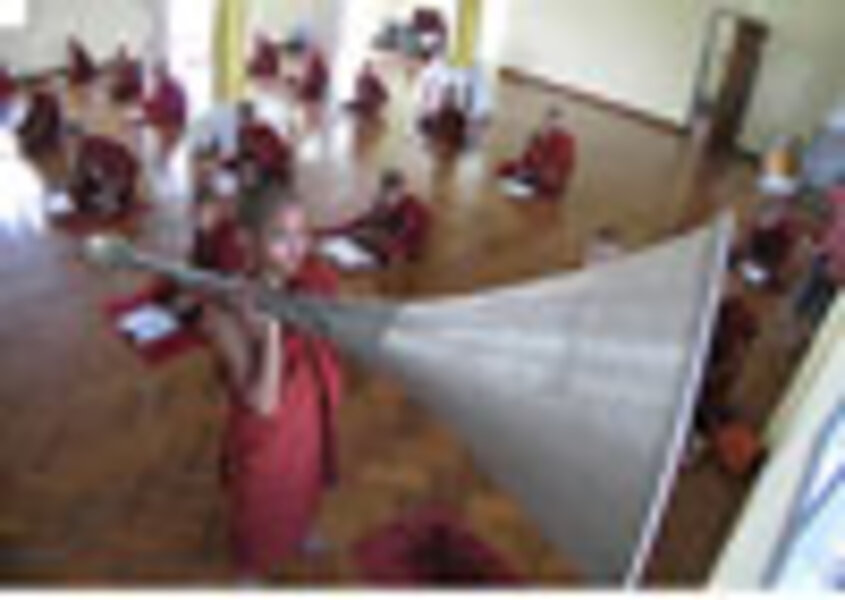Amid aid delays, locals in Burma (Myanmar) rebuild
Loading...
| Rangoon, Burma
Flying home, Burmese sailors are awestruck when they see the Irrawaddy Delta below them. Four weeks after cyclone Nargis hit, much of the delta is still underwater, a murky inland sea of swollen rivers and flooded fields, dotted with soggy clumps of thatch and bamboo that used to be villages teeming with children and water buffaloes.
But then hope emerges: Workers are carving out a second strip at the sparkling new Mingaladon airport, where immigration officers stamp in planeloads of foreign aid workers and Burmese are returning home with handy tools such as electric chain saws.
A small number of foreign relief experts have been allowed into the delta in the past few days. Steve Goudswaard, an expert in responding quickly to disasters and assessing immediate needs, was the first foreigner from World Vision to venture into the delta, which has been off limits to most foreign aid workers until recently. He says it took him almost a week after United Nations chief Ban Ki Moon's historic visit with Burma's leader, Senior Gen. Than Shwe, to finally get government permission to go beyond Rangoon, as local officials in the delta interpret the policy in their own ways.
"The government made a decision in principle, and then it had to work out the details later," he says, after returning to a hotel in central Rangoon from a two-day trip into the delta. "Nobody really knew how the agreement would be applied. It wasn't a simple procedure. We've been trying to work out the system at the same time as the government."
"We were told it would take 48 hours advance notice for clearance. Now we're finding out it's taking 72," he adds.
About 45 UN visa requests have been approved since General Shwe promised last week to allow in "all" legitimate foreign aid workers.
"We haven't been able to get the whole mechanism going. Progress has been slow," Hakan Tongul, deputy director in Burma of the UN's World Food Program, told Reuters.
Burmese leaders rejected criticism of its handling of aid efforts Sunday, after US Defense Secretary Robert Gates accused the generals ruling the country of "criminal neglect."
Burma's deputy defense minister, Aye Myint, in Singapore for a security conference also attended by Mr. Gates, insisted that the government had acted swiftly and was open to foreign aid with "no strings attached." "Through the prompt and immediate supervision of the supervisory central body headed by the prime minister and member ministers, relief camps and hospitals were opened, debris was cleared, emergency power and water supply restored," Mr. Myint said.
Along with Burmese staff and an Indonesian, Mr. Goudswaard took a boat for six hours toward Ngapadaw in the southwest delta, then a smaller boat for two hours to the outer edge allowed by his permit. Beyond lay remote areas where it's not known if anyone has survived, or been reached.
His crew stopped at an expanse of muddy water – what used to be the village of Aut Pyun, home to 127 families. Winds were so strong that they cracked open concrete beams and pulverized brick walls of a school. Only 300 people, about half the population, survived.
Expecting to find people stunned and depressed, he was surprised to see locals rebuilding their homes with the help of organized Burmese relief volunteers and the leadership of monks. "They've bounced back very quickly.... The shock of losing their families is etched in their faces. But they're also taking the initiative to help themselves," he says.
As a member of World Vision's Global Rapid Response Team, Goudswaard has seen many disasters, but this might be the worst. "The impact is probably greater here than the tsunami had in Aceh or Sri Lanka, because it's also the rice bowl...." he says.
Yet many survivors escaped by hurrying to the nearby village of Phing Angon, and into a home opened by four sisters. Monks from across the country then led the relief effort.
The official press in Rangoon is full of tales of local heroism. A headline in the state-run New Light of Myanmar: "Everybody may make donations freely. Everybody may make donations to any person or any area. However, well-wishers are urged to avoid unsystematic donations and acts that may tarnish the image of the nation and its people."
With supplies brought in by compassionate locals, the survivors went to work, rethatching their houses, and covering a clinic with tarps donated by USAID. Goudswaard saw them trying to drain salt out of what used to be a freshwater pond, and collecting rain water in sturdy traditional jars that withstood the winds.
After waiting for two weeks for access, he appeared relieved to finally get the chance to put his field expertise to work. With four planes bringing supplies in the last two days on what he calls "the United Nations air bridge" from Bangkok to Rangoon's sparkling new airport, "it's starting to move as it should," he says.
Goudswaard says it's challenging to make an accurate needs assessment due to the lack of information from the government. The "life-saving stage is probably past us," he says, but steps for the next phase include: providing temporary shelter and helping people rebuild their livelihoods such as by planting rice.
•The writer could not be named for security reasons. Wire services were used.





